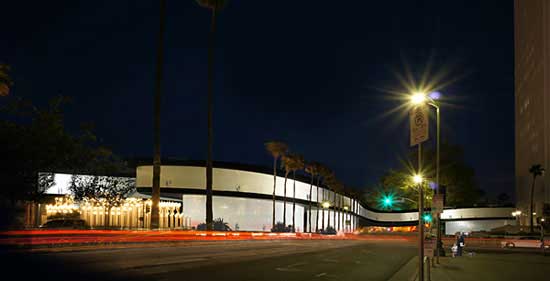Two Los Angeles County museums’ unique but conflicting visions for the future were enough to send an internationally renowned architect back to the drawing board—literally. Now, after a collaborative process that included exploring the grounds of the La Brea Tar Pits with scientists, architect Peter Zumthor is back with a bold new approach for a signature building at the Los Angeles County Museum of Art that avoids the famed Ice Age fossil trove and instead creates a dramatic bridge across Wilshire Boulevard.
Zumthor’s new design for the most part preserves his original concept: a largely transparent building with a shape reminiscent of a curvaceous tar pit. But instead of constructing the entire 400,000-square-foot building on the Hancock Park campus that LACMA shares with the tar pits, he now proposes having one quarter of the structure reach south across Wilshire to what’s currently the museum’s Spaulding Avenue parking lot. One of the new building’s five distinctive glass pavilions—through which passersby will be able to see the museum’s art—would now be located on the south side of the boulevard.
A model of Zumthor’s original plan for the building was displayed last spring as part of a LACMA exhibit intended to inspire public conversation about the project. But Topic No. 1 in that conversation quickly became Natural History Museum officials’ concern that the proposed structure could obstruct future scientific discoveries hidden in the rich subterranean world of micro-fossils.
In the face of such worries, officials of both museums appeared before the Board of Supervisors last September and pledged to work together to preserve the tar pits while creating a new building that would replace several aging structures on the LACMA campus.
The current design, which still must obtain a range of environmental and governmental approvals in order to go forward, grew out of that process.
“Necessity is the mother of invention,” said Supervisor Zev Yaroslavsky, who has directed county funding to a feasibility study of the project that is now underway. The new design “is actually more iconic than his original design. It’s a win-win.”
“We think the design is much better,” agreed Michael Govan, LACMA’s director and CEO. He said the new approach opens up more park space around the tar pits, creates better vistas on a “continuous veranda” around the building and makes a more compelling visual statement by bridging Wilshire.
“It really becomes a landmark,” Govan said.
Zumthor had originally intended the design to be a “love letter to the tar pits,” but as criticism emerged about its possible negative impact on science at the site, he “joked that the tar pits didn’t love it back,” Govan said.
Well, that loving feeling appears to have returned.
“I think the results show that we all worked in good faith to both provide LACMA with an exciting building and to protect and preserve the tar pits,” said NHM director and president Jane Pisano, who walked the site with Zumthor and her team of scientists in February. “It was a chance to really talk to the person who had the challenge of coming up with the solution. I have to say, I was just very impressed by what a good listener he is.”
Museum officials have previously said that it will take a $650 million campaign to bankroll all elements of creating the new building. An updated figure, taking into account a potentially more complicated construction process, will not be available until the feasibility study is completed in the spring.
Meanwhile, though, the collaboration between the two county museums already is paying dividends.
“I personally have had a lot of fun getting to know in more depth the science of the La Brea Tar Pits,” Govan said.
As for Pisano, she said she always felt a good solution eventually would emerge.
“One of the things that I knew for sure was that architects, particularly good architects, thrive when they’re given very difficult design challenges,” Pisano said. “And I think that both the thriving and the design challenges were present in this case.”
Posted 6/24/14







